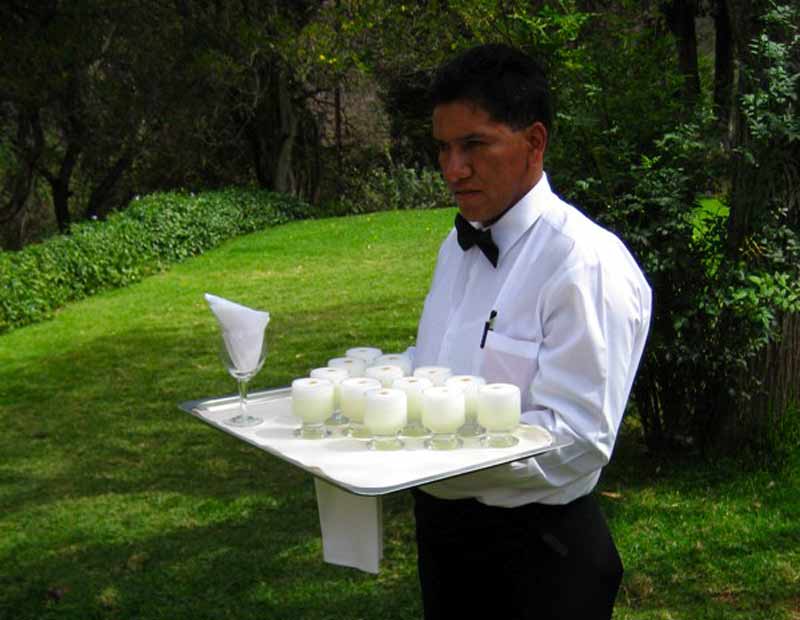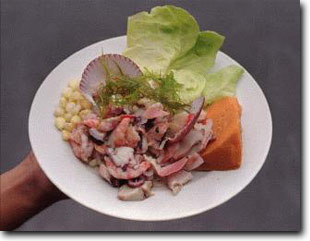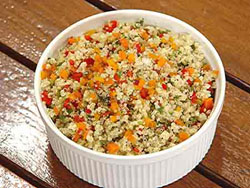



A rich diversity of dishes and ingredients make up Peruvian cuisine
Peru
boasts one of the finest cuisines in the Americas. Recipes such as ceviche
(raw fish marinated
in lemon juice), pachamanca (meat and vegetables cooked underground), chupe
de camarones
(shrimp soup), ají de gallina (spicy chicken) and juanes (cornmash
pastries) are just a few of the
mouth-watering dishes in Peru. Peru's ecological
and climactic diversity has given rise to a major supply of fresh produce,
which any chef
would be inethusaic about. The rich Peruvian fishing grounds abound in fish
and shellfish species, the heart of the
succulent coastal gastronomy; rice, fowl and goat, meanwhile, are the key
ingredients of Peru's north coastal
cooking. In the Andes, meanwhile, delicious ingredients such as the potato
and sweetcorn in all its varieties, plus
cuy (guinea pig) and ají chili pepper are the basis of highland
cooking and are to be found across the country. The jungle
adds its own touch, wild game with a side serving of fried banana and manioc
root. Local fruit varieties such as
chirimoya (custard apple) and lucuma produce incomparable deserts.
Ceviche, (raw fish marinated in lemon juice)
Peru's
most famous dish, is displayed at a Lima
restaurant. Made from sea bass, shrimp, octopus and other
seafood marinated in lime juice, it is served with sweet potatoes,
onions, lettuce and corn.
Quinoa
Quinoa is a cereal grain
from the Andes of Peru and South America, closely related to the amaranth.
Quinoa´s
origins are ancient and was one of the three staple foods, along with corn
and potatoes, used by the Inca civilization. Each year the Inca planted
the first quinoa seeds of the season with a gold type of hoe and at the
solstice the priests bearing gold vessels filled with quinoa made offerings
to their god Inti (Sun god). This grain grows at high altitudes of approximately
9,000 to 13,000 feet above sea level. Quinoa (pronounced kee-noo-ah) contains
more protein than any other grain; on an average of 16.2 percent, compared
with 7.5 percent for rice, 9.9 percent for millet, and 14 percent for wheat.
Its protein is of an unusually
high quality, with an essential amino acid balance similar to milk. Quinoa
when
combined with other grains or soy will boost its protein value. It also provides
starch, sugars, oil (high in essential linoleic acid), fiber, minerals and
vitamins.
Quinoa is easy on the stomach and is tasty,
light and easy to digest and is
delicious and extremely versatile grain. You can also find it in natural
food stores in the US as well as in many grocery stores. It
may be used in place of almost any other grain, including rice, to make
everything from appetizers to desserts. It only takes 15 minutes to prepare
and is great in the summer and winter. Quinoa´s lightness makes it
great to combine in cold dishes like salads and is an ideal source of good
nutrition in the summer and in winter eat it hot combined with meats or
vegetables.

Quinoa Pilaf
Ingredients
Lucuma
Lucuma is an exotic and Peruvian fruit. The
Lucumo is a tree with rough bark and thick green leaves which grows naturally
in the Andean valleys. Its fruit has a greenish/brown skin with yellow/orange
flesh, soft and sweet. It is processed like flour (lucuma flour)
to satisfy the populations needs during the seasons when it is not available
as a fresh fruit. As flour, it is easily canned and exported and is mainly
used to make ice creams, shakes, desserts and
combined with milk. Lucuma has a high content of vitamin B1, Tiamine
and Niacine.

AJI (Andean-Style
Chile Paste) makes 1/2 cup
Chile pastes, made with fresh or dried chiles, are used in soups, stews, and sauces. Many Andean cooks keep containers of different aji pastes on hand in the refrigerator or freezer.
Ingredients:
1 to 3 fresh or dried aji rocoto or 6 fresh or dried aji amarillo or rojo,
aji mirasol, or aji ponca
3 to 4 tablespoons mild salad
oil (canola or corn) or water
1/2 teaspoon salt, or to taste
If you are using fresh chiles, peel them (if desired), seed them, and remove the ribs. You may either blanch the chiles in boiling water or roast them for easier peeling. Coarsely chop the fresh chiles. Combine the chopped chiles, oil, and salt in a blender, and puree. If you have chosen not to peel the chiles, press the mixture through a medium-mesh sieve into a bowl for a smoother paste.
lf you are using dried chiles, soak them in hot water to cover for 30 minutes. Then drain, peel (if desired), seed them, and remove the ribs. Coarsely chop the reconstituted chiles. Combine the chopped chiles, oil, and salt in a blender, and puree. If you have chosen not to peel the chiles, press the mixture through a medium-mesh sieve into a bowl for a smoother paste. The paste may be stored in a tightly covered container in the refrigerator for 1 week, or in the freezer for several months.
NOTES: If none of these chiles, or their substitutes, is available, we suggest using Asian chile-garlic sauce, which you can find in jars in the specialty food section of most supermarkets, as a substitute for the red or yellow aji paste or sauce. The sauce contains garlic, so you may want to reduce the amount of garlic called for in the recipe. Some brands are very hot, so proceed with caution. The commercially available ground aji powder-such as ground aji mirasol-is convenient, but it tends to be hotter than the paste because the chiles are often ground with the seeds and ribs intact. lf a recipe calls for 3 tablespoons of aji paste, substitute 1 1/2, to 3 teaspoons powder, depending on the heat of the particular chile.
Peruvian Pisco Sour
Peruvian
Pisco is a grape brandy or "aguardiente", distilled from fresh
grape. Its
alcohol content is around 42°. The word "Pisscu" means seagull
in quechua, the Inca
language. It is also the name of the port from where it was shipped, as can
be seen in maps
dating back to the late sixteenth century.The
four Pisco varieties are defined by flavor, according to the grape which
has been used:
Pisco puro with a delicate flavor (from non-aromatic grapes
such as Quebranta, Mollar or black grapes);
Pisco Aromatico (aromatic grapes such as Moscatel, Italia, Torontel and
Albilla);
Pisco Acholado (mixture of different grape varieties) and
Pisco Mosto Verde (from grape that has not been fully fermented).Pisco
is the product of good grapes, good soil and an optimum climate.
These virtues are to be found in the pisco-making valleys starting at Cañete, 90 miles south of Lima, Perú. The pisco grapes require a loose sandy loam with high salinity, where its roots can grow deep, and with a pH (a measure of the acidity of the soil) between 6,6 and 7,5. The composition of the soil and the temperature in these valleys enable the grapes to grow vigorously and prodigiously, with sufficient sugar to make a good pisco.
Obviously,
each valley has its own preferred varieties, which have their own characteristics.
Altitude varies from sea level to 4900 ft. Most pisco producers are in
the south of the country. This core area includes the places where liquor
was distilled in colonial times. It has its own history and although many
distilleries have disappeared, or only vestiges remain, many have a lineage
going back many generations and preserve the tradition of Peruvian pisco.
This phenomenon of family ties can be seen in both artisanal
and industrial production. From
Yanuq.com
See the special interest tours link for culinary tours to Peru.
Cultural Expeditions Peru offers:
Customized luxury group tours to experience the cuisine and wines of Peru.
Travel to Peru's Spanish and Andean history, archaeology, and culinary arts and wines.
Travel packages tailored to your interests with expert knowledgeable trip leadership.